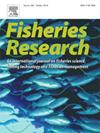Application of a delta-generalized additive model to assess the impact of environmental changes on the spatial distribution of bigeye tuna (Thunnus obesus) in the Indian Ocean
IF 2.2
2区 农林科学
Q2 FISHERIES
引用次数: 0
Abstract
This study estimated the spatial distribution of bigeye tuna (Thunnus obesus) in the Indian Ocean under changing environmental conditions through habitat suitability modeling. Fisheries data from the Indian Ocean Tuna Commission and environmental satellite data from COPERNICUS were used in a delta-generalized additive model approach. This involved separately modeling the probability of presence or absence using binomial logistic regression and the positive catch using lognormal distribution. Results showed that sea surface temperature, mixed layer depth, and chlorophyll-a significantly influenced the presence of bigeye tuna in the Indian Ocean, whereas sea surface height, mixed layer depth, and chlorophyll-a exerted a substantial impact on their density. Adjusted simulated environmental data from 2020 to 2100 under three climate change scenarios (SSP126, SSP245, and SSP585) from Coupled Model Intercomparison Project Phase 6 were utilized to predict the future spatial distribution pattern of bigeye tuna in the Indian Ocean. Bigeye tuna is expected to variedly shift its spatial distribution under the three different climate change scenarios, with SSP585 having the most pronounced changes. Generally, bigeye tuna is predicted to spread poleward from the equator as a result of tropicalization in the higher latitudes.
求助全文
约1分钟内获得全文
求助全文
来源期刊

Fisheries Research
农林科学-渔业
CiteScore
4.50
自引率
16.70%
发文量
294
审稿时长
15 weeks
期刊介绍:
This journal provides an international forum for the publication of papers in the areas of fisheries science, fishing technology, fisheries management and relevant socio-economics. The scope covers fisheries in salt, brackish and freshwater systems, and all aspects of associated ecology, environmental aspects of fisheries, and economics. Both theoretical and practical papers are acceptable, including laboratory and field experimental studies relevant to fisheries. Papers on the conservation of exploitable living resources are welcome. Review and Viewpoint articles are also published. As the specified areas inevitably impinge on and interrelate with each other, the approach of the journal is multidisciplinary, and authors are encouraged to emphasise the relevance of their own work to that of other disciplines. The journal is intended for fisheries scientists, biological oceanographers, gear technologists, economists, managers, administrators, policy makers and legislators.
 求助内容:
求助内容: 应助结果提醒方式:
应助结果提醒方式:


